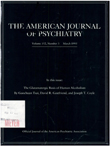Use of the Structured Clinical Interview for DSM-IV Dissociative Disorders for systematic assessment of dissociative symptoms in posttraumatic stress disorder
Abstract
OBJECTIVE: This study compared dissociative symptom areas in Vietnam combat veterans with posttraumatic stress disorder (PTSD) and in Vietnam combat veterans without PTSD. METHOD: The Structured Clinical Interview for DSM-IV Dissociative Disorders (SCID-D) was used to compare dissociative symptoms in 40 Vietnam combat veterans with PTSD and 15 Vietnam combat veterans without PTSD. The SCID-D yields a total score and scores in five symptom areas: amnesia, depersonalization, derealization, identity confusion, and identity alteration. RESULTS: The PTSD patients had more severe dissociative symptoms in each of the five symptom areas of the SCID-D and higher total symptom scores. Amnesia was the symptom area with the greatest difference in scores between the PTSD patients (mean = 3.68, SD = 0.73) and the non-PTSD veterans (mean = 1.06, SD = 0.26). CONCLUSIONS: The finding of higher levels of dissociative symptoms in Vietnam combat veterans with PTSD than in Vietnam veterans without PTSD is consistent with a level of dissociative symptoms in PTSD similar to that in dissociative disorders.
Access content
To read the fulltext, please use one of the options below to sign in or purchase access.- Personal login
- Institutional Login
- Sign in via OpenAthens
- Register for access
-
Please login/register if you wish to pair your device and check access availability.
Not a subscriber?
PsychiatryOnline subscription options offer access to the DSM-5 library, books, journals, CME, and patient resources. This all-in-one virtual library provides psychiatrists and mental health professionals with key resources for diagnosis, treatment, research, and professional development.
Need more help? PsychiatryOnline Customer Service may be reached by emailing [email protected] or by calling 800-368-5777 (in the U.S.) or 703-907-7322 (outside the U.S.).



